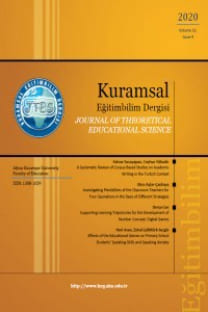In-service Teachers’ Opinions about the Use of Video-based Self-reflection for Pedagogical Development
Reflection is an opportunity to look into the classroom from the outside, to examine the learning process, and to make inferences for pedagogical development. Video recordings of lessons can be used to stimulate self-reflection by capturing the details of the teaching process and by examining the classroom atmosphere. This study aims to investigate teachers' opinions about the use of video-based self-reflection for their pedagogical development. Seven teachers participated in the research. Data were collected through a Pre-interview Protocol, Teachers’ Reflection Reports written for twelve weeks about one recorded lesson per week, and a Post-interview Protocol after the 12-week video-based self-reflection period. The main findings show that the teachers’ video-based self-reflections constitute nine categories and two weeks of video-based self-reflection process resulted in changes in terms of density and content in teachers’ opinions about the use of video-based self-reflection.
___
- Cheung, R. (2009). The use of self-assessment to foster students' learning in teacher education: An experience in teaching practice. Action in Teacher Education, 31(1), 49-57.
- Coffey, A. M. (2014). Using Video to Develop Skills in Reflection in Teacher Education Students. Australian Journal of Teacher Education, 39(9): 86–97. doi:10.14221/ajte.2014v39n97.
- Cranton, P. (2001). Interpretive and critical evaluation. New Directions for Teaching and Learning, 2001(88), 11-18.
- deBettencourt, L. U., & Nagro, S. A. (2018). Tracking special education teacher candidates' reflective practices over time to understand the role of theory in clinically-based teacher preparation. Remedial and Special Education. Advance online publication. doi:10.1177/0741932518762573.
- Dewey, J. (1933). How we think. New York: Heath.Goldman, R., R. Pea, B. Barron, and J. D. Sharon. 2007. Video Research in the Learning Sciences. Mahwah: Lawrence Erlbaum Associates, Inc.
- Farrell, S. C. (2020). Professional development through reflective practice for English-medium instruction (EMI) teachers, International Journal of Bilingual Education and Bilingualism, 23(3), 277-286. doi: 10.1080/13670050.2019.1612840.
- Jao,L., Sahmbi, G., & Huang, Y. (2020). Professional Growth Through Reflection and an Approximation of Practice: Experiences of Preservice Teachers as Teaching Assistants in a Secondary Mathematics Teaching Methods Course, The Teacher Educator, 55(1), 47-65. doi: 10.1080/08878730.2019.1637986
- Jaworski, B. (1998). Mathematics teacher research: Process, practice and the development of teaching. Journal of Mathematics Teacher Education, 1, 3–31. Kleinknecht, M., & Schneider, J. (2013). What do teachers think and feel when analyzing videos of themselves and other teachers teaching?. Teaching and Teacher Education, 33, 13-23.
- Körkkö, M., Morales Rios, S., & Kyrö-Ämmälä, O. (2019). Using a video as a tool for reflective practice. Educational Research, 61(1), 22–37.
- Merriam, S. B., & Tisdell, E. J. (2016). Qualitative Research: A Guide to Design and Implementation (4th ed.). San Francisco: Jossey-Bass.
- Nagro, S. A. (2019). Reflecting on others before reflecting on self: Using video evidence to guide teacher candidates' reflective practices. Journal of Teacher Education. Advance online publication. https://doi.org/10.1177/002248711987270.
- Nagro, S. A., deBettencourt, L. U., Rosenberg, M. S., Carran, D. T., & Weiss, M. P. (2017). The effects of guided video analysis on teacher candidates' reflective ability and instructional skills. Teacher Education and Special Education, 40(1), 7–25. https://doi.org/10.1177/0888406416680469.
- Nagro, S. A., Hirsch, S.E, & Kennedy, M. J (2020). A self-led approach to improving classroom management practices Using video analysis. Teaching Exceptional Children.https://doi.org/ 10.1177/0040059920914329.
- Prieto, L. P., Magnuson, P., Dillenbourg, P. & Saar, M. (2020). Reflection for action: designing tools to support teacher reflection on everyday evidence, Technology, Pedagogy and Education, 29(3), 279-295. doi. 10.1080/1475939X.2020.1762721
- Ross, J. A. & Bruce, C. D. (2007). Teacher self-assessment: A mechanism for facilitating professional growth. Teaching and Teacher Education, 23(2), 146-159.
- Ruffinelli, A, Hoz, S. & Álvarez, C. (2020). Practicum tutorials in initial teacher training: conditions, strategies, and effects of reflective practice. Reflective Practice, 21(1), 54-67. doi: 10.1080/14623943.2019.1708712
- Sablić, M., Mirosavljević, A., & Škugor, A. (2020). Video‑Based Learning (VBL)—Past, Present and Future: an Overview of the Research Published from 2008 to 2019. Technology, Knowledge and Learning https://doi.org/10.1007/s10758-020-09455-5.
- Schon, D. A. (1983). The reflective practitioner: How professionals think in action. New York: Basic Books.
- Shanahan, L. E., & A. L. Tochelli (2014). Examining the Use of Video Study Groups for Developing Literacy Pedagogical Content Knowledge of Critical Elements of Strategy Instruction with Elementary Teachers. Literacy Research and Instruction, 53 (1), 1–24. doi:10.1080/19388071.2013.827764.
- Sherin, M., & van Es, E. (2005). Using video to support teachers' ability to notice classroom interactions. Journal of Technology and Teacher Education, 13(3), 475-491.
- Tripp, T. R., & P. J. Rich. (2012). The Influence of Video Analysis on the Process of Teacher Change. Teaching and Teacher Education, 28(5), 728–739. doi:10.1016/j.tate.2012.01.011.
- Towndrow, P. A., & Tan, K. (2009). Teacher self‐evaluation and power. Teacher Development, 13(3), 285-295.
- van Veen, K., Zwart, R., & Meirink, J. (2012). What makes teacher professional development effective? A literature review. In M. Kooy & K. van Veen (Eds.), Teacher learning that matters: International perspectives (pp. 3–21). Routledge.
- Yıldırım, A. & Şimşek, H. (2016). Qualitative Studies in Social Sciences. Ankara: Seçkin Yayınları.
- ISSN: 1308-1659
- Yayın Aralığı: Yılda 4 Sayı
- Başlangıç: 2008
- Yayıncı: Afyon Kocatepe Üniversitesi Eğitim Fakültesi
Sayıdaki Diğer Makaleler
Anlamlı İş ve İşle Bütünleşme İlişkisinin İncelenmesi
Özlem YILDIRIM TAŞTI, Ali YILDIRIM
Ataman KARAÇÖP, Tufan İNALTEKİN
Fatih KAYAALP, Bayram GÖKBULUT, Elif MERAL, Zeynep BAŞCI NAMLI
Okullarda Motivasyonel Dil ile Yöneticiye Sadakat İlişkisinde Lider-Üye Etkileşiminin Aracılık Rolü
